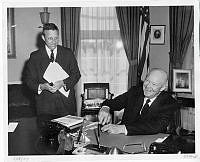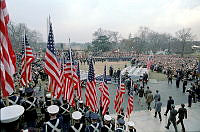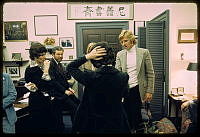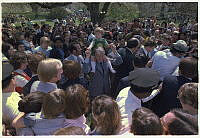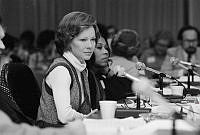Rubenstein Center Scholarship
Lyndon B. Johnson: Forgotten Champion of the Space Race
The hot Florida sun beat down on a crowd gathered at Cape Kennedy on July 16, 1969. As the Apollo 11 mission blasted off and climbed through the blue sky, on its way to land the first astronauts on the moon, a former president stood in the viewing stands. Looking up into the sky, Lyndon Baines Johnson watched intently as a long-awaited and hard-fought dream became reality. At a luncheon the previous day, Johnson spoke about his deep connection with the mission: “I doubt a human could be as concerned or troubled until splashdown as I am or have been.”1

Spiro Agnew and Lyndon B. Jonhson watch the Apollo 11 liftoff.
Wikimedia CommonsThe success of the Apollo 11 mission was the culmination of many years of political, social, and technological effort, with incredible advances that spanned the administrations of four American presidents. President Dwight D. Eisenhower oversaw the creation of the National Aeronautics and Space Administration (NASA). President John F. Kennedy vowed to put a man on the moon “before this decade is out.”2 President Richard M. Nixon successfully landed humans on the moon. However, perhaps no president reached for the stars quite like Lyndon B. Johnson. Johnson’s efforts to advance technology and explore beyond Earth’s atmosphere are often overlooked, with his role in space exploration reduced in comparison to his predecessor and successor.
On October 4, 1957, the Soviet Union launched the world’s first artificial satellite, Sputnik I, into space. In ninety-eight minutes’ time, this beach ball sized object completed its first orbit of Earth and changed the course of history by turning Americans’ attention toward outer space.5 In the aftermath of Sputnik I, the United States found itself unexpectedly bested by Soviet technology. The United States was planning to launch its own satellite, but the Soviets beat them to the finish line.
After World War II, the United States and the Soviet Union had emerged as global superpowers, and the battle for supremacy between these two nations touched on all facets of American life. During the 1950s, anti-Soviet propaganda usually lauded American ideals of freedom and democracy, as well as American ingenuity and creativity, while portraying the communist nation as a “brutish, backward, and totalitarian” society.3 The launch of a satellite demonstrated the Soviet Union’s impressive advancements in space technology and upended these stereotypes, putting the American public and scientific community on edge.4 Many feared that the satellite was also an indicator of missile technology, which could potentially be launched from the Soviet Union and target major U.S. cities.
While President Eisenhower prepared to address Sputnik’s launch from the White House, Senate Majority Leader Lyndon B. Johnson contemplated Congress’ response from his Texas Ranch. Johnson’s wife, Claudia “Lady Bird” Johnson, later recalled the events of that day:
“We were at the Ranch and Lyndon and I and a few friends walked out down the road saying nothing for what seemed like ages. The sky was like velvet and the stars hung close like brilliant diamonds around us. Each of us was pondering what the future now held. We had lived with the sky all our lives, and suddenly it was as though we had never seen it before. That was our launching pad, sort of speak, and the Preparedness Subcommittee of the Senate Arms Services Committee was my husband’s vehicle.”6
Before the evening was over, Johnson launched into action. He made many phone calls, spoke with other legislators, and received approval to conduct a congressional investigation of the U.S. space and defense programs.7 Johnson resurrected and chaired the Preparedness Subcommittee of the Senate Arms Services Committee, originally formed in 1950 following the outbreak of the Korean War, and began holding congressional hearings. Senate Counsel to the Democratic Policy Committee and Preparedness Investigating Committee, Gerald Seigel, recalled that the hearings sought to answer one essential question: “Why did the Russians beat us with [our effort on] this little Geophysical Year Navy project that was supposed to launch an eleven pound satellite?”8
The “Inquiry into Satellite and Missile Programs” began on November 25, 1957 and by January 23, 1958, over 1,300 pages of testimony had been recorded.9 During the course of the hearings, Johnson became convinced that the United States needed to invest in and enhance the U.S. space program. While Johnson and many others, including President Eisenhower, were concerned about national security and the country’s defense capabilities against the backdrop of the escalating Cold War, Johnson also believed that the space program could be a powerful political asset. Additional resources and funds would result in technological advancements that would ultimately carry the United States forward while eclipsing the Soviet program. While President Eisenhower initially hesitated on the issue of the space race, believing the costs were too great and the operations too risky, Johnson believed that there was great potential.10
On February 6, 1958, Johnson took action to advance the space issue. Frustrated with the National Advisory Committee for Aeronautics (NACA), Johnson pushed for the creation of a Special Committee on Space and Aeronautics and a few weeks later became its chair.11 Meanwhile, President Eisenhower had been meeting with the President’s Science Advisory Committee since December. The committee, chaired by Dr. James R. Killian, Jr., proposed to transform NACA into a brand-new civilian government organization, The National Aeronautics and Space Administration (NASA).12
On April 2, 1958, President Eisenhower sent draft legislation to Congress, calling for the creation of the space agency. After debate, Congress passed a bill establishing NASA on July 16. On July 29, President Eisenhower signed the legislation into law. On October 1, NASA launched, and America’s space program was off to the races.13 Johnson’s efforts in Congress were essential to the creation and passage of the NASA legislation. As historian Andreas Reichstein noted, “All actions of Congress with regard to space between 1957 and 1961 can be attributed to Johnson.”14
The creation of NASA was just the beginning of Johnson’s involvement in the space race. President Eisenhower sent Johnson to the United Nations in November 1958, where he delivered a rousing speech, calling for peace and cooperation in space exploration.15 By the end of 1958, NASA also initiated Project Mercury, with the goal of putting men into space.16 Johnson remained interested in the activities of NASA and soon was presented with a new career opportunity as President John F. Kennedy’s Vice President.
When John F. Kennedy became president in January 1961, he supported the space race. In a speech before Congress on May 25, 1961, President Kennedy famously called for funding to put a man on the moon: “First, I believe that this nation should commit itself to achieving the goal, before this decade is out, of landing a man on the moon and returning him safely to earth.”17 Behind the scenes, Kennedy was focused more on international relations and domestic issues, so he appointed Vice President Johnson to chair the nine-member National Space Council. Johnson was already familiar with the council because he introduced the legislation that created it after Sputnik. He also understood that Eisenhower had reduced the council, “from a coordinating body to a purely advisory body.”18
As chairman of the council, Johnson supported the administration’s efforts in the space race. He also continuously pushed President Kennedy and others to pursue more funding for NASA missions from Congress. Although Kennedy and Johnson were not particularly close during their time working together, they were united about the possibility of a United States moon shot.19
Kennedy and Johnson’s desire to accelerate the space program and put a man on the moon was in part motivated by continued advancements in the Soviet space program. On April 12, 1961, the United States found itself bested once again, when cosmonaut Yuri Gagarin became the first human ever to leave Earth’s atmosphere. He completed one successful orbit before returning triumphant.20
However, the United States was not far behind. On May 5, 1961, one month after Gagarin’s successful orbit, astronaut Alan Shepard launched into space aboard the Mercury Freedom 7, becoming the first American to leave the Earth’s atmosphere. Although Shepard did not orbit as Gagarin had done, the successful mission demonstrated that the United States’ program was catching up to the Soviet Union’s.21
As the Mercury missions experienced continued success and plans were made for the future Gemini and Apollo programs, Kennedy and Johnson focused on securing additional funding. Kennedy hoped to encourage the American public to look at the lunar missions as more than just a race with their political adversaries. On September 12, 1962, Kennedy delivered a speech at Rice University in Houston, Texas, where, instead of framing the space race in terms of a conflict with the Soviets, he presented traveling to the moon as a historic challenge to reach a new unexplored frontier. Kennedy lauded NASA’s efforts and explained the need for additional support and funding by appealing to tenets of American exceptionalism. 22
In his efforts to secure further funding, Kennedy appreciated that Johnson had powerful influence in Congress, particularly with the bloc of southern Democratic senators, who Kennedy needed on board for the expansion of the Apollo program. As Kennedy forged ahead with plans for the Apollo program in 1963, Johnson advised him to maintain pressure on targeted representatives, suggesting that they be “called out as soft on communism,” should they refuse to fund space exploration.23 Johnson also pointed out the long-term advantages of pursuing the program, noting that the money invested in research would ultimately benefit the economy as new technologies were developed. He also touted gaining a better understanding of outer space and making new scientific discoveries, as well as providing “greater strength for the educational system both through direct grants, facilities and scholarships and through setting goals that will encourage young people.”24
Unfortunately, President Kennedy did not live to see a human land on the moon. On November 22, 1963, he was assassinated in Dallas, Texas, and Lyndon B. Johnson became president. Johnson immediately stepped into the role of commander-in-chief, comforting a horrified nation, and pledging his efforts to continue many of Kennedy’s policies—including putting a man on the moon.25 Just days after the assassination, Johnson sought to memorialize Kennedy’s contributions by announcing that the Cape Canaveral launch site in Florida would be renamed Cape Kennedy during a televised address on November 28. The following day, Johnson signed an executive order stating that the NASA Launch Operations Center, which included Cape Canaveral, would be renamed the John F. Kennedy Space Center.26
Johnson also continued a tradition, started by Kennedy, of inviting astronauts to the White House in celebration of their achievements. These events provided a national stage to communicate the success of the space program to the American public and the world. Following the Mercury Project, NASA launched Project Gemini in 1965, a human spaceflight program which helped NASA prepare for the later Apollo moon landings. Ten missions flew between 1965 and 1966 and many of the crews had the honor of visiting President Johnson at the White House.27
One of the most memorable occasions occurred on June 17, 1965, when Johnson awarded astronauts James McDivitt and Edward White, as well as Gemini Project manager Charles W. Mathews, the National Aeronautics and Space Agency Exceptional Service Award during a Rose Garden ceremony. The men were invited to the White House following the successful Gemini 4 mission, which included sixty-two Earth orbits over the course of four days and Edward White’s spacewalk—the first American to do so.28
After participating in a motorcade to the U.S. Capitol where a crowd of 50,000 cheered them on, the men had the rare honor of returning to the White House with their families to spend the night.29 They certainly made the most of their short time in the President’s House. Lady Bird Johnson recalled fondly, “By 6 P.M. seven little astronaut children were splashing in the pool, the meals were ordered for the Solarium, and a Walt Disney movie laid on while the grownups prepared for the evening.”30

This photograph by Joseph J. Scherschel shows astronauts James McDivitt and Edward White and their families in the White House swimming pool. They were invited to the White House following the successful Gemini 4 mission to space, which included 62 Earth orbits over four days and the first American spacewalk. The invitation followed their promotion by President Lyndon B. Johnson to the rank of Lieutenant Colonel the week before at an event at NASA's Manned Spaceflight Center in Houston, Texas, and the visit included an overnight stay at the White House. This pool was installed during the Franklin D. Roosevelt administration and was covered over during the Richard M. Nixon administration to create the Press Room.
White House Historical AssociationWhile the children watched a movie at the White House, the astronauts and their wives accompanied the president and first lady to the State Department auditorium to view the NASA color film of their space flight and White’s historic spacewalk. White took the opportunity to describe his walk for the president saying, “I took some big steps. I stepped on Hawaii and onto California and then I stepped right on Texas, Mr. President.”31
After the film, President Johnson delivered the biggest surprise of the day when he asked McDivitt, White, and Matthews to accompany Vice President Hubert Humphrey to the Paris Air Show the next morning. This announcement left little time for preparation. When they returned to the White House, Mrs. Johnson lent several dresses to Patricia McDivitt, Patricia White, and Marietta Mathews for the unexpected trip to Paris. The group finally had dinner in the White House at 11:25 p.m. and then hastily headed to bed to prepare for the 4 a.m. departure to Paris. Their presence at the Paris Air Show was meant to demonstrate the growing power of the United States space program on the international stage.32

This photograph by Joseph J. Scherschel shows President Lyndon B. Johnson awarding CDR Charles "Pete" Conrad, astronaut, the Exceptional Service Medal in the Oval Office. Conrad was the pilot for the Gemini 5 mission (August 21-29, 1965), which broke the Soviet record for spaceflight duration. Along with other missions, Conrad would go on to command the Apollo 12 mission to the moon. In the photograph, he is accompanied by his wife and his children, who are seated at President Johnson's desk. First Lady Lady Bird Johnson is standing at the far right of the frame.
White House Historical AssociationDespite his support for the space program, President Johnson was also plagued by complications from his other presidential policies. The expense of the Vietnam War and Johnson’s Great Society programs forced cuts to NASA’s budget.33 However, to avoid being one upped by the Soviets, Johnson’s administration proposed the 1967 Outer Space Treaty (OST). The treaty outlined international space law, barring nuclear weapons in space and prohibiting individual countries from claiming celestial objects as their own.34 The treaty was signed on January 27, 1967, during an East Room ceremony where Johnson spoke: “This treaty means that the moon and our sister planets will serve only the purpose of peace and not of war…It means that astronaut and cosmonaut will meet someday on the surface of the moon as brothers and not as warriors for competing nationalities or ideologies.”35
Following the treaty signing, Johnson hosted a White House reception honoring Secretary of Commerce John T. Conner. Although the evening started as a joyful celebration, it ended with news of a tragedy. In the middle of the reception, President Johnson learned that astronauts Ed White, Gus Grissom, and Roger Chafee were killed during a fire in an Apollo Command Module while training for the first crewed Apollo flight earlier that evening. President Johnson read the message aloud, resulting in a moment of “frozen shock.” Guests then began to recall their memories of White, Grissom, and Chafee while Mrs. Johnson spoke about her connection with Grissom and White’s wives.36 President Johnson then released a short statement that evening: “THREE valiant young men have given their lives in the Nation's service. We mourn this great loss. Our hearts go out to their families.”37 Following the tragedy, the Apollo program was temporarily paused while an investigation took place. President Johnson attended the astronauts’ funerals several days later.38
The Apollo missions resumed more than a year later and President Johnson continued to support their achievements. On October 11, 1968, astronauts Wally Schirra, Donn F. Eisele, and Walter Cunningham launched into orbit for the Apollo 7 mission. Two months later, on December 21, 1968, astronauts Frank Borman, James Lovell, and William Anders launched the Apollo 8 mission, the final manned mission during Johnson’s presidency.39 President Johnson released an address honoring the mission and promoting astronaut safety: “I am confident that the world’s finest equipment will strive to match the courage of our astronauts. If it does that, a successful mission is assured. Prudence is a [sic] of courage, however, so we must give top priority to astronaut safety as decisions are made each step of the way.”40 The mission was successful, orbiting the moon for twenty hours while Anders snapped the iconic “Earthrise” photograph. It was certainly a high note for the final days of the Johnson administration.

Anders' iconic Earthrise photo, December 24, 1968.
Wikimedia CommonsWhen President Johnson left office, he continued to closely follow the Apollo missions. After several more successful space flights, on July 20, 1969, the world watched as the Apollo 11 Lunar Module touched down on the moon’s surface. Astronaut Neil Armstrong emerged from the spacecraft and delivered the iconic phrase, “That’s one small step for man, one giant leap for mankind.” With these words, Armstrong became the first person to walk on the moon, followed by Edwin “Buzz” Aldrin. It was the end of a 238,900-mile journey for the United States, more than a decade in the making.41
President Johnson enjoyed several years of retirement at his Texas ranch before passing away from a heart attack on January 22, 1973. Following his death, his contributions to space exploration were honored on February 17 when President Richard Nixon announced: “It is with great pleasure today that I sign into law S.J. Res. 37, designating the Manned Spacecraft Center in Houston as the Lyndon B. Johnson Space Center. Few men in our time have better understood the value of space exploration than Lyndon Johnson.”42
On August 27, 1973, on what would have been Lyndon’s 65th birthday, Lady Bird Johnson and daughters Lynda and Luci gathered in Houston to participate in ceremonies dedicating the Lyndon B. Johnson Space Center. They unveiled a new bust of President Johnson to be displayed at the center. NASA Administrator Dr. James C. Fletcher remembered President Johnson as “a crusader in mankind’s conquest” and noted: “No other person did more to move America and the world rapidly into the space age than Lyndon Baines Johnson.”














